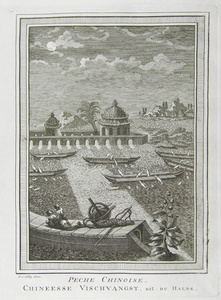| Method | Copper engraving |
| Artist | Jakob van der Schley |
| Published | [A la Haye, Chez Pierre de Hondt, MDCCXLIX. Avec Privilege de Sa Majeste Imperiale, & de Nos Seigneurs les Etats de Hollande & de West-Frise. 1749] |
| Dimensions | Image 188 x 138 mm, Plate 212 x 180 mm, Sheet 270 x 215 mm |
| Notes |
An illustration of a Chinese fish farm from the Dutch edition of the Description de la Chine, part of Prévost's monumental 'l'Histoire Géneral des Voyages.' The plate depicts a pair of fishermen resting beside their nets on a stone pier at the edge of a large sea enclosure. The enclosure is teeming with fish, which jump over and around the empty narrow fishing boats that are anchored nearby. In the middle ground, an arcaded sea-wall encloses two small round buildings and a palm tree. In the distance, a small fishing village in the shadow of a mountain can be seen. The subtitle to the plate suggests that the image is based on the description of Jean-Baptiste du Halde, a French Jesuit who, in 1736, published an encyclopaedic Description de la Chine et de la Tartarie Chinoise. Despite never having travelled in China himself, du Halde's Description became the most widely disseminated book on Chinese geography, culture, customs, and religion available to eighteenth century audiences. Most of du Halde's work was based upon information gleaned from the reports of fellow Jesuits, who had travelled as missionaries throughout China during the previous century. The Histoire Géneral des Voyages was a monumental eighteenth century general history divided according to geographic region. The original volumes were written by Antoine François Prévost d'Exiles, a French author, novelist, theologian, natural historian, and a priest of the Jesuit and Benedictine orders, but continued by numerous other authors after Prévost's death. The earliest books mostly deal with the Far East and South-East Asia, providing a general history of their regions, kingdoms, customs, culture, costumes, natural phenomena and religious beliefs. Much of Prévost's information is derived from the reports of Jesuit missionaries, Portuguese merchants, and famous explorers, from Marco Polo to Sir Francis Drake. Although written in French, the popularity of the Histoire among Dutch audiences meant that many of the illustrative plates and maps published to accompany the work were either re-engraved or subtitled in Dutch by the engraver Jakob van der Schley. Prévost himself had travelled widely throughout the Netherlands, launching his literary career in Amsterdam and the Hague after fleeing the Benedictines in France. Prevost's work on China, and indeed many of van der Schley's plates, owe a great debt to Johan Nieuhoff (1618-1672) , a Dutch traveller who explored much of China, India, and Brazil while in the employ of the Dutch East India Company. Nieuhoff wrote extensively, with a particular focus on China, for his memoirs, and his numerous drawings of Chinese places and people were much copied by later engravers for numerous works of Chinese interest. Nieuhoff's own book became a major source of inspiration for eighteenth century chinoiserie, and are amongst the first western illustrations to depict the Chinese people in a manner which was based upon personal observation rather than the tradition of oriental fantasy. Jakob van der Schley (26th July 1715 - 12th February 1779), also known as Jan von Schley or Jacobus van Schley, was a Dutch engraver and draughtsman. An apprentice of the French engraver Bernard Picart, he is best known for his engravings of the majority of plates in the Dutch edition of 'l'Histoire Géneral des Voyages.' Despite producing mainly maps and views for this work, van der Schley was predominantly a portrait artist and literary illustrator. Condition: Sheet trimmed within plate on left margin as issued. Binders crease and holes to right margin. Clean, crisp impression with partial fleur-de-lis watermark. |
| Framing | unmounted |
| Price | £40.00 |
| Stock ID | 40804 |

